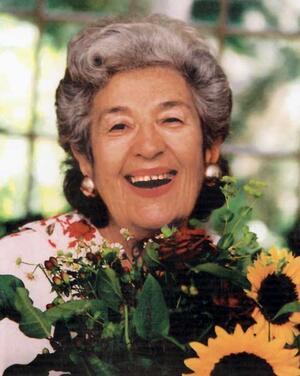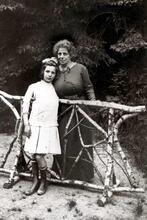Miriam Schapiro
Miriam Schapiro was one of the foremost pioneers in the feminist art movement in the United States. In 1967 she began teaching at UC San Diego and created OX, a computer-generated painting that became an icon of feminist art. In 1971 she and Judy Chicago co-founded the first feminist art program at the California Institute of the Arts, and in 1972 created Womanhouse, a collaborative feminist art space. She invented “femmage” in the 1970s: collages created from objects made or cherished by women, combined through traditionally feminine craft techniques. Through her art and scholarship, as well as her role as co-founder of the feminist art journal Heresies, she showcased the importance of past and present women artists to the art world.
Career and Awards
Miriam (Mimi) Schapiro was one of the foremost pioneers in the feminist art movement in the United States. Nicknamed “Mimi Appleseed” after Johnny Appleseed whose dream was for a land where blossoming apple trees were everywhere (two hundred years later, some of those trees still bear apples), she has opened paths previously closed and unknown to women artists, past and present, trained and untrained. Since 1970, Schapiro raised women’s consciousness through her writing, painting, printmaking, teaching and sculpture. She lectured extensively on feminist issues to professional conferences, university audiences, art classes and women’s groups. Through the use of large scale media and symbols emblematic of the female, she has battled to pay homage to women and their undervalued domestic traditions. Her seminal role in the art world was acknowledged with the esteemed honor of 2002 Distinguished Artist Award for Lifetime Achievement of the College Art Association, the national organization of artists and art historians.
Among her many awards are: Ford Foundation Grant; National Endowment for the Arts Fellowship; Guggenheim Fellowship; Skowhegan Medal for Collage (for her development of femmage); and Rockefeller Foundation Grant for Artists Residency at the Bellagio Study and Conference Center in Italy. Schapiro has also been honored by the National Women’s Caucus for Art and the National Association of Schools of Art and Design. She received six honorary degrees. She exhibited extensively in both individual and group shows, some of which have been of women-only groups. She was a founding member of the Feminist Art Institute in New York, co-founder of the Los Angeles Institute of Contemporary Art and co-founder of the feminist journal Heresies.
Early Life and Family
Schapiro was born in Toronto, Canada, on November 15, 1923, the only child of Russian Jewish parents, Fannie Cohen (1899–1998) and Theodore Schapiro (1898–1999). Both sets of grandparents emigrated from Russia. Her maternal grandfather invented the first movable doll’s eye in the United States and manufactured “Teddy Bears” (named after Theodore Roosevelt). Her paternal grandfather was both a rabbi in an East New York synagogue and a tailor who sewed the arctic clothes for Admiral Peary and his group of explorers. Both men were amateur scholars. Miriam’s maternal grandmother had eight children while her paternal grandmother had six. Both grandmothers were working women, aiding their husbands and rearing their children. Schapiro’s father, an artist and intellectual, was studying at the Beaux Arts in New York City at the time of Miriam’s birth. Later he earned his living as an industrial designer. In 1926 he ran for Congress on the Socialist Party ticket. Later he was the director of the Rand School of Social Science in New York City. Her homemaker mother, an ardent Zionist, was highly supportive of Miriam’s wish to be a professional artist. Miriam began sketching at the age of six.
While at Erasmus Hall High School in Brooklyn from 1937 to 1941, Schapiro, who described herself as a “cultural Jew,” attended Saturday classes at the Museum of Modern Art and Federal Art Project classes in the evenings to study drawing from the nude. Her higher education was at State University of Iowa, Iowa City ( B.A. 1945, M.A. 1947, M.F.A. 1949). In 1946 Schapiro met Paul Brach (b. 1924), a fellow student, and they married that year. She notes that Brach furthered her Jewish identity; he was among the American soldiers who helped to liberate Theresienstadt in World War II. His recounting of his experience affected her deeply. Their son, Peter, was born in 1955.
In 1950–1952, while Brach was on the faculty at the University of Missouri, Mimi worked as a secretary for a rabbi and as a children’s art teacher in Columbia, Missouri. From 1952 to 1955 she functioned as a children’s art teacher, real estate secretary, and bookshop assistant in New York. Since 1955 she has been a full-time artist. Schapiro exhibited as an Abstract Expressionist in the 1950s in New York City. An acknowledged member of the “second generation” of this predominant movement of the 1950s, she was a figurative painter whose work was characterized by subtle colors and painterly, gestural strokes. Women appeared in her paintings during these early years of her career, whether they were appropriations of famous art historical masterpieces or incorporated photographs of celebrities such as Judy Garland or Gloria Swanson. In 1967 the couple moved to California where, as acting professor in the art department of the University of California at San Diego, La Jolla, she was among the first artists to recognize the potential of the computer. She produced a series of computer hard-edged, geometrical paintings and drawings in collaboration with David Nalibof, a physicist. Collaboration with others has characterized much of Schapiro’s art.
Groundbreaking Feminist Artwork
In California Schapiro participated in women’s consciousness-raising groups. In the late 1960s her involvement in the budding feminist movement was manifested in her computer-generated painting OX (1967). Painted in pinks and orange with mechanical precision, OX became one of the signature works of the early feminist art movement because of its vaginal reference. Subsequently, the term “central core imagery” was designated by the feminist artist Judy Chicago and Schapiro after discovering the recurrence of the image in a number of works by other women artists.
In the 1970s, after years of personal and professional experiences as a female in a patriarchal art world, Miriam became profoundly committed to the cause of feminist art. In 1971, together with Chicago, she founded and led the nation’s first feminist art program at The California Institute of the Arts, Valencia. Chicago and Schapiro team-taught classes for women artists and co-directed Womanhouse (1972), a Feminist Art Program students’ collaborative. In this much-publicized environment, an old seventeen-room Hollywood house scheduled for demolition was transformed into rooms whose decoration and furnishing reflected various feminist concerns. In collaboration with Sherry Brody, Schapiro contributed The Dollhouse (1972) to the program. With its six separate miniature rooms, some filled with fantasy elements, The Dollhouse is one of the best known icons of feminist art. In this assemblage, with its stage-like settings of toy furniture, wood, fabric, paint and paper, the only male included is a stuffed fabric nude model for the artist’s studio. This room is the most politically significant in the carefully crafted work. The use of fabric, which became a major material in the evolution of her mature career, is a symbol to celebrate the anonymous women who worked in their homes doing quilting, cooking, child-raising and interior decorating. A merger of irony and artistic skill, this installation ultimately questions female connections and limitations.
Schapiro regarded her work as a personal and political struggle to publicize and strengthen the achievements of anonymous women of the past and their traditional art forms. Her feminist polemic concerns the plight of all women, whether from third-world nations, ancient cultures or our modern era. For example, in her writing she referred to Native American women who embroidered quillwork on their buckskin bags. She selected, bought and collected items associated with homemaking such as lace, brocade, silks, sequins, wool, quilts, needlework, rick rack, handkerchiefs, beads, swatches of taffeta, valentines, wall paper and fabric pieces and incorporates them in her work. New artworks were sometimes started by items such as tea towels, doilies, valentines or ribbons that women give her at various lectures around the nation. Her political aim was to put an end to the alleged insignificance of these female symbols and prevent further trivialization of the overlooked traditions they recall.
Her development of “femmage,” a conflation of textile arts and painting in which the twentieth-century collage, pioneered by Picasso in 1912, is transformed into an idiom of female empowerment, was designed to boldly confront sexist thought and dignify women. In the 1970s she recast collage, which she defined as “pictures assembled from assorted materials,” into works which through combined painting and pasted items commemorate hidden, marginalized elements of female domestic culture as practiced for centuries. Materials relating to needlework, appliquéing, brocading, clothes making and home decorating are used for their historical value in terms of women’s artistic heritage. Sometimes using paper, but primarily large canvases with highly saturated colors of acrylic paint, Schapiro layered patterned fabric swatches into feminist collages. She often selected fabrics with floral designs to further accentuate women’s traditional art forms. The use of monumental scale and patterned or decorative fabric pieces merged in the “femmage” was a strong response to a patriarchal history of art.
To use her own term, Schapiro had a “lexicon of imagery” for subjects that further her mission. Prominent motifs such as the house, the fan and the heart appear frequently in her oeuvre as single themes or in a combination of themes. In her “femmages” she fought the age-old prejudice against craft, usually associated with women and domestic life, with her swatches of fabric collaged onto canvas to form teapots and cups, sentimental stitched handkerchiefs, hearts and flowers, aprons or houses.
The absence of women artists in basic college art history textbooks propelled Schapiro to make a change. As a member of the board of the College Art Association she argued for greater recognition of women artists. Her series of “collaborations” with female role models in the history of art are ways to bring about awareness of ancestry. With her mixed-media approach she assembles a reproduction of a painting by a woman painter such as Mary Cassatt (1844–1926)and surrounds it with a collage of ribbons and fabrics. Other artists honored in this series are Frida Kahlo (1907–1954), Elisabeth Vigee-Lebrun (French Neoclassical painter, 1755–1842), Berthe Morisot (French impressionist painter, 1841–1895), and Sonia Delauney.
Schapiro was one of the leaders of Pattern and Decoration (also labeled Pattern Painting), a major movement of the mid- to late 1970s which offered an alternative to the rigidity and persistence of the Minimalist and Conceptual movements of the 1960s. A major advocate of large-scale decoration, she had frequently incorporated colorful ribbons and fabrics into her canvases, often over a geometric pattern, thus creating a feminine aesthetic. While both male and female P & D artists were inspired by the dimensions and bold look of her work and began to use ornamental grids and patterns in brilliant colors on their canvases, they did not all share her concern with validation of women’s motifs and traditions, which was a bold step in a century overwhelmingly dominated by abstract painting.
Later Career and Legacy
In the mid-1980s she returned to figurative work, using fabric and more dynamic brushwork and motifs. Inspired by theater and dance, her large canvases display the creative woman in action on stage. In I’m Dancing as Fast as I Can (1984), Schapiro symbolically presents herself as a dancer surrounded by her parents. The dancer motif recalled the creative female as well as her own childhood dance lessons. The circles surrounding the central figure are a quotation from Sonia Delauney. Without Delauney’s typical combination of acrylic paint and fabric on canvas, Schapiro in 1987 characterized Marlene Dietrich in her famous role as chanteuse in Der Blaue Engel. In the late 1980s and 1990s she created numerous “collaborations” with Frida Kahlo or early twentieth-century women artists such as Natalia Goncharova (Russian cubist painter, 1881–1962), Liubov Popova (Russian constructivist painter, 1889–1924), Varvara Stepanova (Russian painter and designer, 1894–1958), Alexandra Exter (Russian painter and designer, 1882–1949), Delauney and others. These works, both on paper and on canvas, pay tribute to her Russian artistic female ancestors. Conservatory (1988) is one of a number of tributes to Frida Kahlo, who is placed in an imaginary setting among the decorative background materials, together with Tlazolteotl, an important and complex earth-mother goddess from the Aztec pantheon. Schapiro’s use of brilliant color, jewelry, and patterned costume are signature marks of Kahlo.
Schapiro explored her Jewish identity in a number of works which appeared around the mid-1980s: Golem, a series on Frida Kahlo, Sonia Delauney and Four Matriarchs, four stained glass windows portraying biblical women such as Rachel and Leah, at Temple Sholom, Chicago. Two more recent works—My History and Lost and Found—use the house-shaped canvas she developed in the past. On the roofs of both canvases is a menorah and within the houses is a grid of windows each displaying Jewish elements. In My History there are a hallah cover, photos of Anne Frank, Frida Kahlo and the young Chagall in an art class, and the Star of David Jews were required to wear under the Nazis. In Lost and Found more of Schapiro’s Jewish iconography is presented: a photograph of concentration camp survivors, a Hebrew illuminated manuscript page, a Jew at the Western Wall, a pouch for phylacteries, and other significant emblems.
Schapiro’s work is included in numerous collections in the United States, Germany, Israel and Australia.
As a leading figure in the feminist art movement, she encouraged and challenged the aspirations of countless women artists for a bright future. Her impact is seen in the feminist art history courses taught throughout colleges and universities and in the number of women artists now represented in many art history texts.
Miriam Schapiro died on June 20, 2015 in Hampton Bays, N.Y. She was 91.
Books
Broude, Norma, and Mary Garrard. The
Power of Feminist Art: The American Movement of the 1970s, History and Impact.
New York: 1994.
This is one of the definitive studies of the first decade of feminist art.
Numerous contributors, including Schapiro. Article with accompanying photographs
of Womanhouse.
Networks and organizations of feminist politics are discussed. Chapters on
collaborations, Pattern and Decoration movement. Extensive selected bibliography
and highly selective chronology with illustrations.
Gouma-Peterson, Thalia. Miriam
Schapiro: Shaping the Fragments of Art and Life. New York: 1999.
A thorough monograph of Schapiro’s personal and artistic growth. Detailed
interpretations of many of the works of art accompanied by many beautiful
illustrations. This is by far the finest source for a real grasp of her political
mission and her aesthetic thought.
Exhibition Catalogues
“Miriam Schapiro: Works on Paper—A Thirty-Year Retrospective,” curated and
organized by Robert A. Yassin, Director, Tuscon Museum of Art, 1999.
Catalogue contains wonderful article by Paul Brach, Schapiro’s husband, and
a foreword by Gloria Steinem. Illustrations provide a chronology of her developing
imagery. Fifty-four color plates that help one understand her recurrent designs
and themes.
Journal Articles
Broude, Norma. “Miriam Schapiro and ‘Femmage’”: Reflections on the conflict
between Decoration and Abstraction in Twentieth-Century Art.” Arts
Magazine, February 1980: 83–87.
An instructive coverage of the conflict between the hierarchy in the fine
arts. Abstraction has always dominated and has been identified with the macho
artist. Decoration has held a lower rank, although Matisse and Kandinsky are
brought in as examples. Schapiro’s Mary
Cassatt and Me is compared to Duchamp’s famous appropriation of Mona
Lisa. The article helps provide understanding of Schapiro’s accomplishments.
Schapiro, Miriam and Meyers, Melissa. “Waste Not, Want Not: Femmage.” Heresies 1:4 (Winter 1977–1978). Primary document published by Schapiro clarifying femmage. She indicates her interest in collage, woman as makers of art objects to document her culture.
Interviews
Smith, Beryl, Joan Arbeiter, and Sally Swenson. “Miriam Schapiro.” in Lives
and Works: Talks with Women Artists. Vol. 2, London: 1999, 139–157.
Schapiro discusses some of the paintings, the Zeitgeist of the early feminist
period, how making her art is difficult for her, and her stance on feminist
art.





